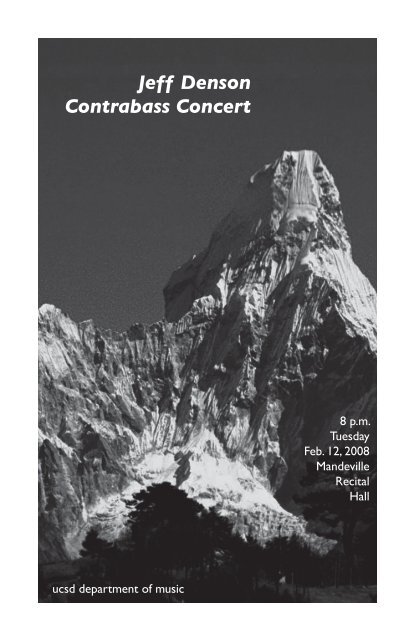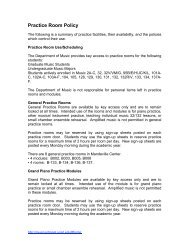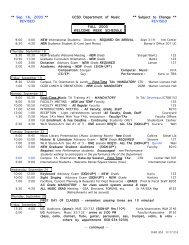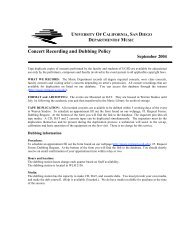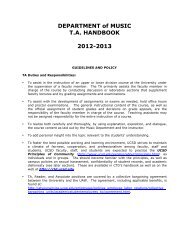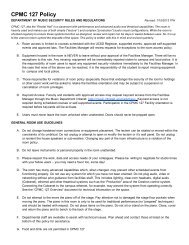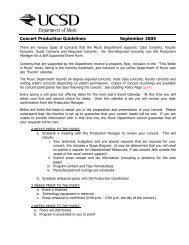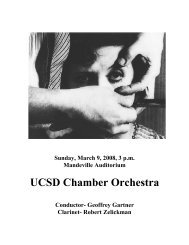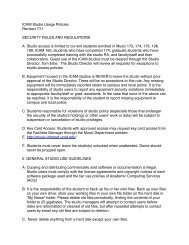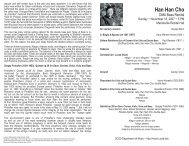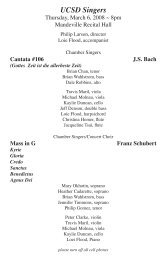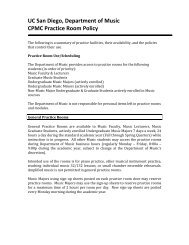Jeff Denson Contrabass Concert - Intranet
Jeff Denson Contrabass Concert - Intranet
Jeff Denson Contrabass Concert - Intranet
Create successful ePaper yourself
Turn your PDF publications into a flip-book with our unique Google optimized e-Paper software.
<strong>Jeff</strong> <strong>Denson</strong><br />
<strong>Contrabass</strong> <strong>Concert</strong><br />
ucsd department of music<br />
8 p.m.<br />
Tuesday<br />
Feb. 12, 2008<br />
Mandeville<br />
Recital<br />
Hall
Please turn off cell phones<br />
ucsd department of music<br />
http://music.ucsd.edu
<strong>Jeff</strong> <strong>Denson</strong><br />
DMA Double Bass Recital<br />
Tuesday February 12, 2008<br />
Psy (1989) Luciano Berio<br />
Monody II for Solo Double Bass (1964) George Perle<br />
Reise med Bat uten Bat (1988) Antonio Bibalo<br />
S. Biagio 9 Agosto ore 1207:<br />
Ricordo per un contrabbasso solo (1977) Hans Werner Henze<br />
Kicho (1974) Astor Piazzolla<br />
Luciano Berio (b. Oneglia, Italy, October 24, 1925)<br />
Berio studied composition at the conservatory in Milan<br />
with Giorgio Ghedini and and Giulio Paribeni, as well as later<br />
studying with Luigi Dallapiccola at the Berkshire Music Center in<br />
1951. Through his work he has done extensive exploration into<br />
serialism, electronic music, and aleatory procedures in composition<br />
and performance. From 1963-1972 he lived in the United States<br />
while teaching at Mills College, Julliard, and Harvard University.<br />
Psy for solo double bass was composed in 1989 for the<br />
birthday of a friend, but it remained unperformed until 1993 when<br />
it was premiered in Rome by the Italian double bassist, Carrado<br />
Canonici. From the first note, this short solo piece takes flight with
a dramatic sense of urgency and impact, with an almost unrelenting<br />
onslaught of atonal sixteenth notes. Nearing the end of the piece<br />
you encounter a lyrical oasis; however you quickly find that it was<br />
merely a mirage as you are thrown back into a whirlwind catapulting<br />
you to the piece’s austere finale.<br />
George Perle (b. Bayonne, N.J., 6 May 1915)<br />
Composer, theorist, and educator, Perle received his Ph.D.<br />
from New York University in 1956 as well as having studied<br />
privately with composer, Ernst Krenek in the early 1940’s. He has<br />
a profound interest in the music of the Second Viennese School<br />
(composers Arnold Schoenberg, Alban Berg, and Anton Webern),<br />
which have served as the foundation for his own musical language<br />
in which he calls Twelve Tone Tonality. This theory of twelve<br />
tone composition is described in his book Twelve Tone Tonality<br />
(Berkley 1977).<br />
Monody II for Solo Double Bass was written for (the<br />
former UCSD Professor of Double Bass) Bert Turetzky in 1962.<br />
This piece is a testament to the enormous lexicon of tone color and<br />
sonic possibilities available with the double bass. Perle explores<br />
a host of some of the various extended techniques available, both<br />
arco and pizzicato, on the instrument through his close collaboration<br />
with Mr. Turetzky, and pushes the entire register and dynamic<br />
ranges to their limits. Rhythmically, the piece is written on a free<br />
plane, by dispensing with the use of bar lines the “meter” is dictated<br />
by each phrase independently. The use of temporal and implied<br />
temporal changes exclusively throughout this piece gives it a constant<br />
feeling of unrest. By use of repetition and sudden changes in<br />
metrical grouping (i.e. triplets, sixteenth notes, quintuplets, etc.),<br />
the illusion of a tempo change is presented. This feeling of almost<br />
constant fluctuating tempi, coupled with equally as frequent timbral<br />
and dynamic changes make for an engaging work. Harmonically,<br />
the work is representative of Perle’s own personal take on the<br />
twelve tone system, while every phrase presents all twelve of the<br />
chromatic tones, they are not presented in the strict non-repeating<br />
fashion of dodecaphonic music. From violent to darkly lyrical and
from whimsical to mysteriously whispered, this piece communicates<br />
its message through some of the many possible characters<br />
that can emerge from this massive instrument.<br />
Antonio Bibalo (b. 1922 Trieste, Italy)<br />
Bibalo began studying piano at an early age and later received<br />
his degree in piano performance from the Conservatoire in<br />
Trieste in 1946. He was well on his way of establishing his name<br />
as a concert pianist in Europe when he decided drop his career as a<br />
performer and move to London in 1953 to study composition with<br />
Elizabeth Lutyens, one of England’s pioneers of twelve tone music.<br />
In 1968 Bibalo became a Norwegian citizen and since that time has<br />
been honored with various awards, including being made a Knight<br />
of St. Olave (1st Class) in 1992, and in the same year was awarded<br />
the Lindeman Prize.<br />
Reise med bat uten bat for Soprano og Contrabas (Boat<br />
Journey without a Boat for Soprano and Double Bass) was composed<br />
in 1988 and premiered at the Bergen International Festival in<br />
1989; it was based on a series of four short poems by the Norwegian<br />
poet and playwright, Cecilie Loveid.<br />
(Poems Translated from Norwegian)<br />
Spartan Piece with Garbage-piles and Leftovers<br />
her sport is swimming while she looks at the world<br />
around her she performs a bath the only thing she’s<br />
a master in she’s tackling her nerves comfortably<br />
water breathes pores gurgles her accomplished swimming her<br />
quack quack her boat her longing for Egypt<br />
beyond decay come quickening when all she<br />
knows is water
Bull-fighter (The Choice)<br />
the inhuman and gruesome bull-fighter<br />
awaited an answer fame the theater tradition<br />
was it the ritual struggle between him and<br />
the beast he knew that down to his fingertips the noble bull<br />
and blood filled both him and the beast<br />
look at him now! now it seems he’s given<br />
up seeking our regard our confirmation<br />
the foolery he seeks will breed a<br />
bird with no lance no bandarillas by loving<br />
the great brown hide the earthmother before departure<br />
theater is torture<br />
Burial Boat<br />
just before she dies<br />
they bring the dentist to cheer her<br />
he fits her with new teeth she gets to try<br />
43 pairs of italian shoes before deciding on<br />
86 she’s asked to choose between 3 new<br />
wigs one slender one ample and one fairly fitting she’s<br />
asked if she wants young men and dance on board<br />
and light light she always has loved water<br />
and the light’s green darkness<br />
The Kiwi Prince<br />
the night cracked open and revealed<br />
the kiwi prince dance mud-bedecked<br />
and after dancing he caressed his night-bird<br />
in front of his lovesick admirers<br />
where are we going?<br />
(The texts are partially abridged in the score.)
Cecilie Loveid had this to say about her poems: “The work might<br />
just as well be called ‘A Dream-Journey in Four Pictures’ or ‘A<br />
Picture-Journey in Four Dreams.’ Four paintings were the original<br />
inspiration.”<br />
First Poem: Spartan Piece with Garbage-piles and Leftovers<br />
(after a painting by Dominique Gauthier). “Longing for an<br />
original state, water, womanly essence, she rejects routine, she just<br />
wants to float, flee...”<br />
Second Poem: Bull-fighter (the choice) (after a painting by<br />
Jean-Michel Alberola). “[This] represents the struggle between<br />
the womanly and the masculine forces [in her]. Relationship to the<br />
masculine, both in herself and in living men, symbolized by bullfighting.<br />
I’m thinking here of the conflict between Ishtar’s celestial<br />
ox an Gilgamesh. Still an original state, but already with a contemplative,<br />
divided modern conscience.”<br />
Third Poem: Burial Boat (after a painting by Helene Delprat).<br />
“The dance of life on board...the woman knows that she<br />
will die, but she wants to live, to dance. We are floating in the<br />
womanly element, in a boat, but are drawn towards the water itself<br />
underneath.”<br />
Fourth Poem: The Kiwi Prince (after a painting by Patrick<br />
Lanneau). “Now she’s in woman heaven, an exotic erotic land<br />
where the potent Kiwi Prince, a sorcerer, dances.”<br />
The first movement, “Prelude”, begins with a solo bass<br />
cadenza that sets the tone for the movement. From out of nowhere,<br />
like a bolt of lightning before the roar of thunder, bow strikes<br />
string with a sforzando attack and disappears off into the distance<br />
just fast as it had appeared. Returning from whence it came, a<br />
quiet but unrelenting tremolo steadily crescendos from a whisper<br />
to a roar, and once more recesses back into the ether. The cadenza<br />
immediately continues with a series of disquieted, seemingly unanswered<br />
calls, setting the stage for the entrance of the soprano, and<br />
the ensuing drama that unfolds. Here we find the character of the<br />
text and that of the bass contrasting one another (or at least on the<br />
surface); while the text describes the woman in her bath releasing<br />
her tension through the water, the bass represents the world outside
of this context: intense and unpredictable. In the second movement,<br />
“Capriccio”, the bass once again opens the movement up<br />
with a solo intro that sets the tone for the movement. In the “Capriccio”,<br />
the bass personifies the struggle between man and beast:<br />
the gruesome fight between the bull-fighter and the bull. This time,<br />
in the third movement, “Novellette”, the soprano opens the movement<br />
with a short statement and is quickly joined by a somber<br />
accompaniment of quarter notes in the bass. After the initial opening,<br />
the bass changes to a more whimsical, or playful accompaniment.<br />
Much like the text, the bass maintains a constant balancing<br />
of grave and lighthearted content in this movement. In the final<br />
movement, “Nocturne”, the soprano opens with an extended solo<br />
cadenza, of text-less syllables. After the soprano cadenza we hear<br />
an abridged, two-bar reprise of the opening bass cadenza of the<br />
“Prelude”, which leads into the body of the movement. Here the<br />
bass depicts the dancing of the flirtatious Kiwi Prince with a string<br />
of lyrical triplet melodies. When the final question of the text is<br />
posed, “Where are we going?” it is echoed by a repeating triplet<br />
melody in the bass as it crescendos and decrescendos off into an<br />
abyss of longing.<br />
Hans Werner Henze (b. Gutersloh, Westphalia 1 July, 1926)<br />
Prolific composer and conductor, Henze studied composition<br />
at the State Music School in Brunswick (1942-44), and in<br />
1946 studied with Wolfgang Fortner at the Institute for Church<br />
Music in Heidelberg, as well as attending Darmstadt summer<br />
courses studying privately with Rene Leibowitz. Henze’s earlier<br />
work has been compared to the styles of Hindemith, Fortner, and<br />
Stravinsky and later works to reflect influences of Mahler, 19th<br />
century Italian opera, and classical formal procedures.<br />
S. Biagio 9 Agosto ore 1207: Ricordo per un contrabbasso<br />
solo (S Biagio August 9th 12:07pm: Recollection for double bass<br />
solo) was composed in 1977 for Dieter Lange (instructor of double<br />
bass at the Music Academy of Lucerne and an orchestra member<br />
of the Zurich Opera). This piece is one of three compositions by<br />
Henze for the double bass: <strong>Concert</strong>o for Double Bass and Orchestra<br />
written for double bass virtuoso, Gary Karr in 1964, and
Serenade (which was originally written for cello in 1949 and later<br />
arranged for double bass by Lucas Drew, professor of double bass<br />
at the University of Miami in 1981). S. Biagio 9 Agosto ore 1207:<br />
Ricordo per un contrabbasso is a deeply dramatic and lyric piece<br />
that dances on the edge of tonality; flirting with it, but remaining in<br />
the ambiguity of its atonality. The opening four notes of the piece<br />
pose a melancholic query upon which is immediately repeated two<br />
more times (with slight deviation) in order to insure its establishment<br />
as the central motif of the piece. These four pitches (C, D,<br />
F#, and G#) are the 1st, 2nd, 4th, and 5th scale degrees of a whole<br />
tone scale. This harmonically ambiguous set of pitches helps set<br />
the plaintive and mysterious sentiment of the composition. The<br />
first section of the piece (A) comes to an equally mystifying cadence<br />
on a variation of the opening motif. This opening section<br />
(A) is the only section that repeats in the piece, and by doing so,<br />
Henze plants the seeds of a musical memory that’s roots twist and<br />
turn under the body of the piece until it is finally presented for<br />
“recollection” in its whispered finale. While the composition is<br />
atonal, it holds a hierarchical distinction for certain pitch sets, or<br />
intervallic schemes, such as whole tone segments, major sevenths,<br />
and both major and minor thirds (frequently performed as double<br />
stops).<br />
At the top of the score there is a note to the performer,<br />
which reads, “the author begs his collegues bass players to play<br />
the piece in this normal tuning.” “Normal tuning,” refers to the<br />
standard tuning of the double bass in fourths, from lowest string<br />
to highest string: E, A, D, G. This note is meant to dissuade the<br />
performer from using “solo tuning” (which is where each string is<br />
tuned one whole step higher than the standard tuning: F#, B, E, A);<br />
I can only speculate here that his purpose in making this request<br />
was to capitalize on the darker sound that would be attained when<br />
using this standard tuning, as opposed to the brighter and more direct<br />
sound that occurs when the bass is in solo tuning. In contrast<br />
to the dramatic extremes of dynamic markings in this piece (from<br />
pppp to ffff) there are especially subtle changes in tempi that create<br />
an almost subconscious awareness of an ebb and flow of temporal<br />
movement between the sections.
Astor Piazzolla (b. Mar del Plata, Argentina 11 March 1921, d.<br />
Paris, France 4 July 1992)<br />
Piazzolla spent most of his childhood in New York City<br />
with his family, where he was exposed to jazz and the music of J.S.<br />
Bach. During this time he began to play the bandoneon and tango<br />
music, after his father. In 1937 he returned to Argentina where<br />
he studied composition with Alberto Ginastera, while performing<br />
regularly in night clubs with various tango bands. In 1953,<br />
at the urging of Ginastera, he entered one of his compostions into<br />
a competition and won a grant from the French government to<br />
study composition in Paris, with the legendary French composition<br />
teacher, Nadia Boulanger. Boulanger encouraged Piazzolla to<br />
embrace his experience with tango and allow its influence on him<br />
to shine through in his own compositions. Piazzolla has composed<br />
music for orchestra, various chamber ensembles, and film, but his<br />
writing for his own quintet is perhaps the most well known. His<br />
compositions fuse folkloric Argentine tango, with jazz, classical,<br />
and contemporary music; and with this fusion he is credited with<br />
founding the musical genre: Tango Nuevo. The role of the double<br />
bass in Piazzolla’s music is a versatile one; it requires a high level<br />
of virtuosity with both arco and pizzicato playing (barring this<br />
particular arrangement of Kicho which is to be played solely arco),<br />
as well as strong sense of pulse and time. The bass serves as the<br />
heartbeat of Piazzolla’s music; it sets the time and drives the rhythmic<br />
intensity of the ensemble.<br />
Kicho was composed in 1974 for the original double bassist<br />
in the Astor Piazzolla Quintet, Kicho Diaz. This is a fiercely<br />
passionate piece that showcases not only the propulsive rhythmic<br />
drive that can be created with the double bass, but the singing lyric<br />
voice of the instrument as well. Kicho opens with an extended<br />
solo double bass cadenza that foreshadows the motivic material of<br />
the body of the piece. While this composition is a solo feature for<br />
the double bass, there is a dialog with the piano where the roles<br />
of soloist and accompanist are traded back and forth, creating an<br />
exciting interplay.


